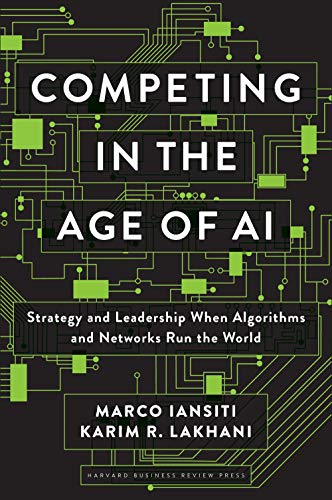Print | Kindle(eBook) | Audiobook
Title: Competing in the Age of AI: Strategy and Leadership When Algorithms and Networks Run the World
Authors: Marco Iansiti and Karim R. Lakhani
Published: 2020 by Harvard Business Review
Rating: 8/10
Theme: The authors observed that a new breed of firms, characterized by digital scale, scope, and learning, is eclipsing traditional managerial methods and constraints, colliding with traditional firms and institutions, and transforming our economy. Software, analytics, and AI are reshaping the operational backbone of the firm.
In Competing in the Age of AI, Authors Marco Iansiti and Karim R. Lakhani argue that reinventing a firm around data, analytics, and AI removes traditional constraints on the scale, scope, and learning that have restricted business growth for hundreds of years. From Airbnb to Ant Financial, Microsoft to Amazon, research shows how AI-driven processes are vastly more scalable than traditional processes, allow massive scope increase, enabling companies to straddle industry boundaries, and create powerful opportunities for learning—to drive ever more accurate, complex, and sophisticated predictions.
The book describes the profound implications of artificial intelligence for business. It is transforming the very nature of companies—how they operate and how they compete. When a business is driven by AI, software instructions and algorithms make up the critical path in the way the firm delivers value. This is the “runtime”—the environment that shapes the execution of all processes.
Favourite Takeaways – Competing in the Age of AI
Transformation is about more than technology; it’s about the need to become a different kind of company. Confronting this threat does not involve spinning off an online business, putting a laboratory in Silicon Valley, or creating a digital business unit. Rather, it involves a much deeper and more general challenge: Rearchitecting how the firm works and changing the way it gathers and uses data, reacts to information, makes operating decisions, and executes operating tasks.
AI DIsruption
AI is the “runtime” that is going to shape all of what we do.—Satya Nadella, Microsoft CEO”
AI is becoming the universal engine of execution. As digital technology increasingly shapes “all of what we do” and enables a rapidly growing number of tasks and processes, AI is becoming the new operational foundation of business—the core of a company’s operating model, defining how the company drives the execution of tasks. AI is not only displacing human activity, it is changing the very concept of the firm.
As such, the first truly dramatic implications of artificial intelligence may be less a function of simulating human nature and more a function of transforming the nature of organizations and the ways they shape the world around us.
The Challenge Ahead
AI can render skills and talents obsolete, from driving a car to managing a traditional retail establishment. Digital networks can alter and transform accepted approaches to social and political interaction, from dating to voting. The broad deployment of AI could threaten millions of jobs in the United States alone. And beyond the erosion of capability, threats to traditional skills, and other direct economic and social impact, we are increasingly vulnerable as an increasing portion of our economy and our very lives become embedded in digital networks.
Rethinking the Firm
Ant Financial employs fewer than ten thousand people to serve more than 700 million customers with a broad scope of services. By comparison, Bank of America, founded in 1924, employs 209,000 people to serve 67 million customers with a more limited array of offerings. Ant Financial is just a different breed.
Business and Operating Models
The value of a firm is shaped by two concepts. The first is the firm’s business model, defined as the way the firm promises to create and capture value. The second is the firm’s operating model, defined as the way the firm delivers the value to its customers.
The AI factory
The AI factory is the scalable decision engine that powers the digital operating model of the twenty-first-century firm. Managerial decisions are increasingly embedded in software, which digitizes many processes that have traditionally been carried out by employees.
Experience from Netflix and other leading firms underlines the importance of a few essential AI factory component
Data pipeline:
This process gathers, inputs, cleans, integrates, processes, and safeguards data in a systematic, sustainable, and scalable way.
Algorithm development:
The algorithms generate predictions about future states or actions of the business. These algorithms and predictions are the beating heart of the digital firm, driving its most critical operating activities.
Experimentation platform:
This is the mechanism through which hypotheses regarding new prediction and decision algorithms are tested to ensure that changes suggested are having the intended (causal) effect.
Software infrastructure:
These systems embed the pipeline in a consistent and componentized software and computing infrastructure, and connect it as needed and appropriate to internal and external users.
Capability Foundations
The most obvious challenge in building an AI-centered firm is to grow a deep foundation of capability in software, data sciences, and advanced analytics. Naturally, building this foundation will take time, but much can be done with a small number of motivated, knowledgeable people.
Network vs Learning Effect
Network effects describe the value added by increasing the number of connections within and across networks, such as the value to a Facebook user of having connections with a large number of friends, or access to a broad variety of developer applications.
The most important value creation dynamic of a digital operating model is its network effects. The basic definition of a network effect is that the underlying value or utility of a product or service increases as the number of users utilizing the service increases.
Learning effects capture the value added by increasing the amount of data flowing through the same networks—for example, data that may be used to power AI to learn about and improve the user experience or to better target advertisers.
Multihoming
The first and most important force shaping value capture is multihoming. Multihoming refers to the viability of competitive alternatives, specifically to situations wherein users or service providers in a network can form ties with multiple platforms or hub firms (“homes”) at the same time. If a network hub faces competition from another hub connecting to a network in a similar way, the first network hub’s ability to capture value from the network will be challenged, especially if the switching costs are low enough for users to easily use either hub.
Disintermediation
Disintermediation, wherein nodes in a network can easily bypass the firm to connect directly, can also be a significant problem for capturing value. From Homejoy to TaskRabbit—that provides only a connection between network participants. After the first connection is made, most if not all of the value created is delivered, and it’s difficult to hold a user accountable to the network hub for ongoing rents.
Network Bridging
Network bridging involves making new connections across previously separate economic networks, making use of more-favorable competitive dynamics and different willingness to pay. Network participants can improve their ability to both create and capture value when they connect to multiple networks, bridging among them to build important synergies.
Strategic Collisions
A collision occurs when a firm with a digital operating model targets an application (or use case) that has traditionally been served by a more conventional firm. Because digital operating models are characterized by different scale, scope, and learning dynamics from those of traditional firms, collisions can completely transform industries and reshape the nature of competitive advantage.
Conclusion
We live in an important moment in the history of our economy and society. As digital networks and AI increasingly capture our world, we are seeing a fundamental transformation in the nature of firms. This removes historical constraints on scale, scope, and learning and creates both enormous opportunity and extraordinary turbulence. But despite all this newfound digital automation, it seems that we can’t quite do away with management just yet.
The challenges are just too great, too complex, and too amorphous to be solved by technology (or technologists) alone. But leading through these changing times will require a new kind of managerial wisdom, to steer organizations from full-scale firms to new ventures, and from regulatory institutions to communities.



1 Comment
Pingback: 100 Books Reading Challenge 2021 – Lanre Dahunsi